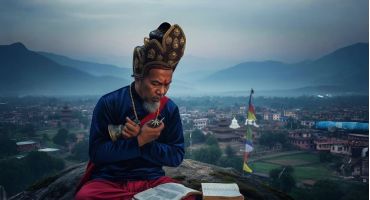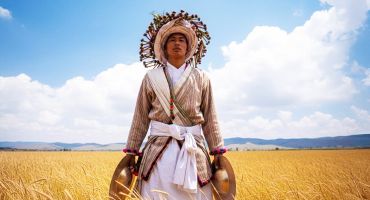Part 1 of the article introduces Ghatu as a rich narrative song and dance tradition of the Gurung people, primarily performed in rural areas of Western and Central Nepal. It highlights its sociocultural importance, emphasizing its role in fostering social cohesion among the Gurung, Magar, and other communities. The Ghatu performance involves slow, trance-inducing dances that enact scenes from local mythology, particularly the story of Queen Amberwati and King Pashramu, with three main types of Ghatu: Barahmase, Kusunda, and Sati. The article also discusses the performance’s connection to agricultural cycles, particularly the belief that a successful Ghatu performance ensures a good harvest, and the ritualistic invocation of nature spirits during the performance. Read Part 1
Though Ghatu may appear at first glance as a traditional song and dance form celebrated for its elegance, fluidity, and the sustained grace of its physical choreography, it holds far greater significance from a cultural perspective. It serves as a deeply symbolic ritual, forging connections between performers and their history, environment, and spiritual beliefs. Beyond its aesthetic appeal, Ghatu functions as a source of cultural memory, a communal rite of passage, and a powerful expression of the Gurung worldview.
A typical performance can range from a few hours to several days. While the narrative content of Ghatu performances varies depending on the type performed, it usually begins with the invocation of the Ghatu Deuta, or spirits of King Pashramu and Queen Amberwati, key figures in the mythological narrative of Ghatu. The Guru, a figure of immense cultural and spiritual authority, chants mantras to summon these spirits into the bodies of the Ghatuli, the young female dancers. These dancers, chosen for their prepubescent purity, are believed to be uniquely capable of embodying divine energy. The trance state they enter is vital for the performance, signaling their role as intermediaries between the human and the divine. The trembling, closed eyes, and fluid movements of the dancers during the trance are viewed as signs of spirit possession, creating an intensely sacred atmosphere.
Guided by the Gurumas (female spiritual guides), the Ghatuli reenact mythological stories and also symbolize the connection between human vulnerability and spiritual transcendence. The dancers selected for these roles represent purity and sacred power, with their uncombed hair and Gurung Cholo (traditional dress) serving as symbols of their divine transformation. This unique interplay of ritual, gender, and spirituality challenges conventional patriarchal norms, portraying women as both protectors and vessels of divine energy. The unadorned simplicity of symbols like the Ghatuli’s loose hair and their rhythmic gestures represents their complete surrender to the divine, while the sacred headgear reinforces their spiritual connection. These symbols not only carry spiritual meaning but also tie the ritual to the natural and cosmological elements of Gurung life.

Every Ghatu performance beautifully embodies the Gurung people’s deep connection to the cyclical nature of time and existence. For the Tamu Gurung, time is not a linear progression but a flow, deeply intertwined with the natural and agricultural cycles that sustain their lives. This philosophy finds expression in the very arrangement of Ghatu, where the repetition of melodies and the circular grace of the dances reflect the timeless patterns of planting and harvesting rice. Each movement and refrain, is almost a ritual that resonates with the life in the hills, drawing performers and audiences alike into harmony with the cosmos.
The Ghatu tradition is meticulously structured, requiring every step to be performed with ritualistic precision, leaving little room for improvisation. It transforms into a sacred ceremony where the Ghatuli become vessels for the Ghatu Deuta, who are channeling divine spirits through their dance. Ritual objects such as the Birpatta, a sacred offering of fried rice and turmeric, play an essential role, serving as protective shields against malevolent energies. The Mandali, or performance space, is ritually cleansed with cow dung and sacred water to create an environment sanctified for invoking the divine. These practices integrate elements of shamanism and animism, embodying the belief in divine possession and the influence of the spiritual world on human life.
The aesthetic and symbolic elements of Ghatu hold great significance, where all movements are infused with meaning. The dancers’ graceful rotations, gentle bows, and synchronized arm gestures embody the Gurung ideal of Sallala pani bagey jastai (flowing like water). This imagery, while capturing the smooth, fluid nature of the dance, also pays homage to the Gurung reverence for water, a life-giving force. The dance movements themselves mirror the winding patterns of mountain streams, which are as vital to the Gurung people’s daily life as they are to their spiritual worldview. The choreography’s soft, flowing lines, devoid of sharp angles, are harmoniously complemented by the rhythmic pulse of the Maadal (drum), which aims to create an experience that is both visually and sonically attuned to the natural world. This fusion of body and ‘flow’ becomes a living tribute to the harmony between the earth, the water, and the people.

The unique vocal style of Ghatu adds a cultural richness to the performance. Typically, there are two to four primary singers, known as Gurumas (spiritual guides or female singers), each contributing personal variations to the melody, which creates a layered and intricate texture. This deliberate asynchrony—where singers breathe independently and embellish different sections of the melody—reflects the collective spirit of the Gurung people. It requires a deep sense of mutual awareness, embodying the Gurung value of milijuli—working together in unity. The Guru leads the group with subtle cues, ensuring the narrative and musical integrity of the performance, while allowing space for individual creativity within the traditional framework. Linguistically, Ghatu songs employ an archaic language, neither Nepali nor Gurung, which only the Guru can partially interpret. This linguistic mystery enhances the sacredness of the performance, setting it apart from everyday life and emphasizing its ritual nature. It also highlights the Guru’s role as the keeper of cultural knowledge, bridging the mystical and the mundane.
The emotional intensity of Ghatu reaches its peak during the Ghatu Selauni ritual on the final day. In this ceremony, the spirits of the Ghatu Deuta are honored and bid farewell through offerings to the river. This moment, filled with the deep sorrow of the Ghatuli as they emerge from their trance, captures the ritual’s liminal nature. It serves as a powerful reminder of the fleeting connection between the human and divine, and the cyclical renewal that follows.
The spiritual essence of Ghatu is rooted in a belief in unseen powers and divine intervention. Performers see themselves not as dancers, but as divine agents enacting the deeds of gods and goddesses. This belief transforms their perception of the dance, as they enter a trance that alters their sense of being. Ghatu dancers often report vivid visions of deceased ancestors and otherworldly realms, reinforcing the connection between the physical performance and spiritual awakening. These experiences shape both the dancers’ and the community’s belief in the ritual’s healing and protective powers. The adherence to ritual, such as the proper selection of dancers based on age and spiritual possession, is critical. If even a small mistake occurs, such as forgetting verses or allowing ineligible dancers, it is believed that the performance will fail, and the consequences could be severe.
Ghatu can be viewed as a sacred ritual that uses symbolic elements to navigate and express abstract, often contradictory, dimensions of belief. It serves as a reflection of a cosmological framework, exploring the relationship between humans and the divine, as well as the unseen forces that shape their world. However, Ghatu has not been immune to the pressures of modernization. Economic challenges, urban migration, and the influence of formal education and state policies have disrupted the traditional rhythms of Gurung life, leading to shorter performances and a dilution of some ritualistic practices. The roles of the Guru and Ghatuli, once sacred and exclusive, have become more flexible, with older women and less specialized drummers occasionally taking part. These changes highlight both the challenges Ghatu faces and its capacity to adapt to contemporary realities. But for those who value ethnic indigenous cultures, Ghatu offers a rich opportunity to explore the intersections of ritual, traditions, and modernity, standing as a testament to the resilience of indigenous practices and their ability to evolve while preserving their core essence





Leave a Reply